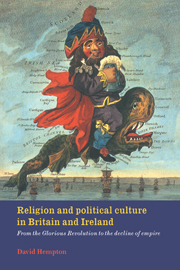 Religion and Political Culture in Britain and Ireland
Religion and Political Culture in Britain and Ireland Book contents
- Frontmatter
- Contents
- Preface
- 1 The Church of England: a great English consensus?
- 2 The Methodist revolution?
- 3 Evangelical enthusiasm and national identity in Scotland and Wales
- 4 The making of the Irish Catholic nation
- 5 Ulster Protestantism: the religious foundations of rebellious Loyalism
- 6 Religion and political culture in urban Britain
- 7 Religion and identity in the British Isles: integration and separation
- 8 Conclusions
- Select bibliography
- Index
5 - Ulster Protestantism: the religious foundations of rebellious Loyalism
Published online by Cambridge University Press: 06 January 2010
- Frontmatter
- Contents
- Preface
- 1 The Church of England: a great English consensus?
- 2 The Methodist revolution?
- 3 Evangelical enthusiasm and national identity in Scotland and Wales
- 4 The making of the Irish Catholic nation
- 5 Ulster Protestantism: the religious foundations of rebellious Loyalism
- 6 Religion and political culture in urban Britain
- 7 Religion and identity in the British Isles: integration and separation
- 8 Conclusions
- Select bibliography
- Index
Summary
The religious geography of eighteenth-century Ireland was largely the product of land confiscations, population migrations and the colonising policies of Tudor and Stuart monarchs. In the seventeenth century nowhere else in Europe (with the possible exception of Bohemia where the entire Protestant gentry class was expropriated) experienced such a dramatic inward population movement or such an upheaval in the religious composition of its landowning elite. In 1600 more than 80 per cent of Irish land was owned by Roman Catholics, but by 1700 this proportion had fallen to around 14 per cent and was still falling. Nowhere was the impact of such changes more evident than in the ancient province of Ulster which received large numbers of Anglican and Presbyterian settlers. Religion, land ownership and ethnic identity were thus at the centre of profound divisions in Ulster society, which by the eighteenth century had a luxuriant tradition of historical conflict upon which to draw. The fact that the Church of Ireland was the Established Church of a landed minority, that Ulster Presbyterianism was virtually a state within a state, and that Roman Catholicism was the creed of a defeated race ensured that the province's religious life would have more than its fair share of turbulence. To some extent this was eased in the first half of the eighteenth century by the relative stability of Hanoverian rule and by the fact that each of the major religious denominations ministered to pre-assigned communities and only occasionally attempted any kind of controversial proselytism.
Nevertheless, as the high immigration statistics show, social, economic and religious grievances were never far from the surface.
- Type
- Chapter
- Information
- Religion and Political Culture in Britain and IrelandFrom the Glorious Revolution to the Decline of Empire, pp. 93 - 116Publisher: Cambridge University PressPrint publication year: 1996


